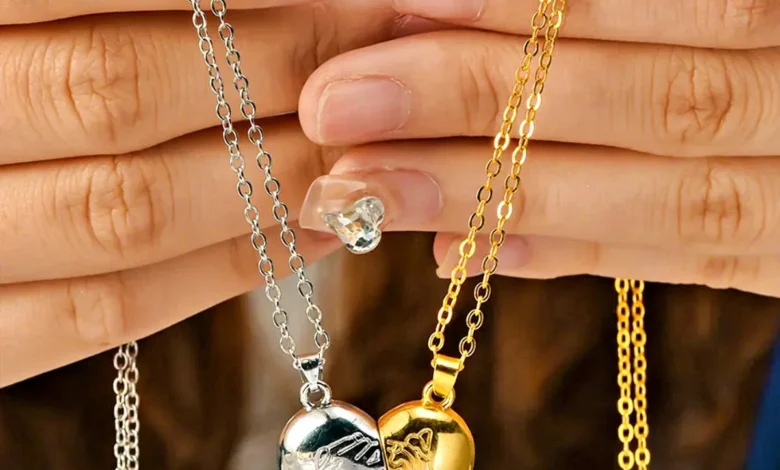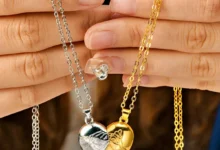How Do Matching Promise Rings Compare to Other Couple Jewelry Like Necklaces?

In the realm of romantic expression, jewelry has long served as a powerful medium for couples to symbolize their connection. From the timeless engagement ring to the simple, coordinated bracelet, these items are more than adornments; they are wearable declarations of love. Among these, matching boyfriend and girlfriend rings, particularly promise rings, have surged in popularity. But how do they truly compare to other popular forms of couple jewelry, such as necklaces? The distinction lies not just in their placement on the body, but in the profound depth of meaning, daily interaction, and symbolic weight they carry, setting them apart as a uniquely powerful token of commitment.
The Dimensionality of Symbolism: A Constant, Conscious Reminder
At first glance, a matching necklace set and a pair of promise rings might seem to serve the same purpose. Both can be customized, crafted from similar materials, and exchanged in a meaningful moment. However, the nature of their symbolism differs significantly.
A necklace is often worn close to the heart, a beautiful and romantic notion. It can be a pendant with coordinates, a locket with a photo, or two halves of a whole that fit together. Its symbolism is powerful but often passive. It rests under clothing, out of sight, a secret known mostly to the wearer. It is a cherished keepsake, but one that can be easily tucked away.
Matching promise rings, on the other hand, are inherently active and participatory. They are worn on the finger, one of the most functional and visible parts of the body. Every time you use your hands—to type, to drive, to hold a coffee cup, to reach for your partner—you see the ring. It serves as a constant, conscious reminder of the promise made. This isn’t a symbol hidden near the heart; it’s a symbol actively engaged with the world. It is a vow that is literally at your fingertips, involved in every action you take. This constant visibility reinforces the commitment throughout the day in a way a necklace, often hidden under a shirt, cannot.
The Practicality of Permanence: Designed for Daily Life
When selecting jewelry for daily wear, especially for a boyfriend who might not be accustomed to it, practicality is a paramount concern. This is where the choice of material, such as tungsten rings, becomes a critical differentiator.
Necklaces, particularly delicate chains, are vulnerable. They can snag on clothing, break during physical activity, or become a safety hazard in certain manual jobs or hobbies. This often leads to them being removed and, consequently, forgotten or left behind. Their wear is often situational.
Modern matching rings, especially those made from tungsten carbide, are engineered for resilience. As discussed, tungsten rings are prized for their exceptional scratch-resistance, durability, and comfortable weight. They are designed to withstand the rigors of an active lifestyle. A man working with his hands, hitting the gym, or pursuing outdoor adventures can wear his tungsten promise ring without worry. It won’t bend, scratch easily, or lose its polish. This “wear-and-forget” (in the best sense) practicality ensures the symbol is always present, making it a more integral part of one’s daily identity than a necklace that must be frequently removed.
This concept of utilitarian permanence is what separates romantic gifts from transactional ones. A corporate customer gift, like a branded necklace, is designed for occasional, formal wear. It’s a reminder of a business relationship in specific contexts. A tungsten promise ring is the antithesis; it is meant to be a permanent fixture, utterly divorced from the realm of commerce and deeply embedded in the personal, sometimes messy, reality of daily life. It’s a symbol that is built to last, just like the commitment it represents.
The Unity of Design: A Cohesive Statement vs. Separate Pieces
Another key difference lies in the perception of the jewelry as a unified set.
Matching necklaces, while beautiful, are often two distinct pieces. Each person wears their own pendant, which may be a half of a heart or a separate charm. While they complement each other, they can also function as complete, standalone pieces of jewelry. The connection, while meaningful, is conceptual.
Matching promise rings are, by their very nature, a cohesive unit. They are identical or intentionally complementary bands. Their power lies in their symmetry. Seeing the same ring on your partner’s hand as the one on your own creates a powerful visual bond. It’s a direct and unmistakable statement of unity. This visual harmony is constantly reinforced when you hold hands, gesture while talking, or simply have your hands resting near each other. The rings create a silent, visible dialogue between the couple that is immediate and undeniable. A necklace lacks this constant side-by-side comparison and the powerful statement of mirrored commitment.
The Cultural and Social Weight: Reading the Fingers
Society has long been conditioned to “read” rings on fingers for information about a person’s relationship status. A ring on the fourth finger of the left hand, in many cultures, immediately signals “taken,” “engaged,” or “married.” While promise rings don’t have a single traditional finger (often worn on the left ring finger or the right hand), they actively participate in this cultural language.
Wearing a ring in this visible location is a public declaration. It communicates to the world that you are in a committed relationship. It can politely deter unwanted advances and proudly announce your connection without a word spoken. This social function is a significant aspect of their meaning.
A necklace does not carry this same immediate social weight. There is no cultural code for what a necklace signifies about one’s relationship status. Its message is far more private and personal, only revealed if the wearer chooses to share its story. Therefore, promise rings function as both a private symbol and a public proclamation, while necklaces remain almost exclusively in the private realm.
The Ritual of Exchange and Wear
The act of giving and receiving also differs. Putting a necklace on someone can be a tender, intimate moment, but it is often a one-time assistance. The recipient then manages the necklace themselves.
The exchange of rings, however, is a ritual steeped in ceremony. Placing the ring on your partner’s finger is a deliberate and symbolic act, often accompanied by words of promise. This mirroring of engagement and wedding traditions adds a layer of gravity and intentionality to the gesture. Furthermore, the act of wearing it is consistent and personal; you put it on yourself each day, reaffirming your commitment through that simple action.
Conclusion: A Matter of Depth and Engagement
So, which is the better choice? The answer is not absolute, as it depends entirely on the couple and the message they wish to convey. Matching necklaces are a profoundly romantic gift, perfect for those who prefer a more private, intimate symbol worn close to the heart. They are beautiful, sentimental, and excellent for occasions where rings might be impractical.
However, matching boyfriend and girlfriend rings, particularly modern, durable options like tungsten rings, offer a more profound, integrated, and active symbol of commitment. They are:
- Constantly Visible: Providing a daily, conscious reminder of the bond.
- Practically Indestructible: Designed for 24/7 wear through all of life’s activities.
- A Unified Statement: Creating a powerful visual symbol of symmetry and partnership.
- Culturally Significant: Acting as a public declaration of commitment.
- Ritualistic: Involving a meaningful exchange and a daily reaffirmation.
They transcend the nature of a simple gift, unlike the impersonal nature of corporate customer gifts, and become a part of the wearer’s identity. In the comparison between promise rings and necklaces, rings ultimately provide a deeper, more engaged, and enduring testament to a couple’s promise, making them a uniquely powerful choice for solidifying a modern relationship.



